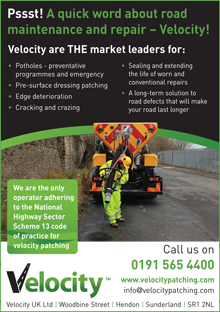eNews
Issue 7 - Summer 2012
RSTA News
Winter road maintenance threatened by summer flooding
The summer’s torrential rain and flooding have left local councils with a £200 million repair bill for roads, bridges and pavements. Funding for essential winter maintenance could be used to carry out repairs meaning that roads will be unable to cope with the rigours of winter freezing.Following record breaking levels of rain during April, May and June, many roads and pavements have been badly cracked or even washed away. Among the worst hit areas is Newcastle-upon-Tyne where the city council has estimated that floods have caused £9 million of damage. In Devon repairs costing £5 million have so far been identified with less than half the road network being surveyed so far. Northumberland County Council has identified £1.4 million of emergency repairs.
Understandably, hard pressed local authorities have not budgeted for these repairs and due to continued funding cut backs they do not have the extra necessary resources. This could have serious consequences for the state of our roads next year. The RSTA is supporting calls by the Local Government Association for the Government to establish an emergency fund for structural repairs as it did following the severe floods of 2007.
Failure to provide such a fund will mean that local authorities will have to use essential winter maintenance funds repairing the damage caused by this year’s summer flooding. The result will be short-term and long-term deterioration of the road network. The problems will be made far worse if we have another severe winter like those experienced in recent years. The government has a significant underspend of hundreds of millions of pounds from cancelling or postponing road schemes. This should be used to repair and maintain the roads that we do have.
Road maintenance is a good start to get Britain working
A new report from the CBI highlighting the economic benefits a well maintained local road network has been welcomed by the RSTA.The report, ‘Bridging the Gap: Backing the Construction Sector to Generate Jobs’, seeks to forward the potential of the construction industry to help deliver a private sector-led economic recovery. In particular it makes the case for an industry-government partnership to stimulate repair, maintenance and improvement (RMI) work and highlights how investing in maintaining and improving the local road network would be a positive step towards creating work and helping attract future private sector investment.
The local road network is the UK’s greatest infrastructure asset. Yet, two-thirds of businesses believe that the road network has deteriorated in the last five years. Investing in the local road network would not only make the UK a better place to do business but would offer a significant number of local and national construction job opportunities. The RSTA welcomes the CBI’s call for local authorities to prioritise RMI work within existing spending budgets with investment in roads being a good starting point.
Welsh road maintenance funding welcomed
The decision by the Welsh Government to provide up to £170 million over the next three years to local Welsh councils for highways maintenance is a step in the right direction.The money is being provided under a 22-year ‘mortgage-style’ agreement to help offset cuts in public spending. It will allow Welsh highway authorities to address the £200 million gap that has been estimated by BBC Wales research to be necessary to bring the local Welsh road network up to scratch.
The Welsh Government is to be commended for taking this action to help local highway authorities have access to funding to address the backlog in road maintenance. However, the councils need to ensure that they invest this money into real long-term maintenance and not just emergency patch-and-mend.
Road safety concerns mirror reduced maintenance spending
The findings of different individual studies have underlined the close correlation between increased road deaths and reduced investment in road maintenance.The latest road safety report from the Transport Select Committee has showed that 1,091 people were killed on England’s roads in 2011. This is a 3% increase compared to 2010. It is significant that this report was published in the same month as a survey into the continued deterioration of the road network.
The survey, by the GMB union, reports that one in 20 of England’s roads have more potholes than a year ago. The research found that 30% of the roads in England need attention with 25% showing some deterioration and 5% showing serious deterioration and requiring urgent remedial action. The research is based upon automatic surveys carried out in each local authority during 2010/11 using scanner vehicles which assess the surface conditions of A, B and C classed roads. Of all the local authorities the Isle of Wight had the worst roads in England with 55% of all roads needing attention. Next in the league for the worst roads is North Lincolnshire with 47%, followed by the City of London, Nottingham and Camden all with 42%.
The GMB research findings are supported by the Annual Local Authority Road Maintenance (ALARM) survey published earlier this year which reported that the condition of the local road network in England and Wales continues to deteriorate as local authorities fight a losing game of patch-and-mend rather than invest in a programme of preventative road maintenance. It is also an expensive game as it costs only £2/m2 to surface dress and maintain a road but costs on average £78/m2 to repair potholes.
The ALARM survey reports a local authority annual road maintenance funding shortfall of £800m. It seems to be no small coincidence that at a time when local authorities are cutting back on road maintenance because of budget cuts forced onto them by government there are increased concerns over road safety.
There is a distinct link between road surface condition and road safety. Budgetary cut-backs means that local authorities need to get more for less. Planned programmes of road maintenance and the use of recognised anti-skid surfacing techniques will deliver roads that are not only safer for drivers and pedestrians but are also cheaper to maintain.
High friction surfacing for improved road safety
Despite being recognised as playing a major role in improving road safety, high friction surfacing’s acceptance in the UK is under threat from Councils heeding to reduce their highway maintenance spend. The Road Surface Treatments Association (RSTA) has developed a number of initiatives to help progress and deliver best practice for its wider installation.High friction surfacing is a proven road surface treatment that increases skid resistance and reduces braking distance thereby reducing the potential for accidents. Typical locations for high friction surfacing include road junctions, approaches to traffic lights, pedestrian crossings and roundabouts as well as road stretches that have high accident levels. First used in the USA in the 1950’s using epoxy resin binders, the development of a range of alternative resin processes have increased surface durability and performance. There are two types of high friction surfacing: hot applied and cold applied. Hot applied works by adhesion through heat application to the road surface whilst cold applied works by adhesion to the road through chemical bond.
With a skid accident reduction of often 50% being reported the success of high friction surfacing speaks for itself: it saves lives and money. Treatment with high friction surfacing makes potentially high risk road locations far safer for both drivers and pedestrians and the financial savings of achieving this are considerable. With the associated accident and investigation costs of non-motorway fatal accidents calculated to be £1.4million, the application of high friction surfacing offers considerable financial value.
Despite the benefits of high friction surfacing and significant market growth in the UK since the 1960’s, over the last few years the market has witnessed a serious decline due in large part to local authority perceived concerns about surface life (durability) and increasing costs. However, since the 1980’s this cost has been able to be balanced against a broader savings strategy with allocated accident investigation and prevention budgets proving the investment savings from high friction surfacing against the cost of accidents and casualties. A third issue was the lack of best practice guidance and practical operative training.
As the focal point for the road surface industry, RSTA with support from ADEPT (Association of Directors of Economy, Environment, Planning and Transport), has now put in place new industry guidance to address client concerns over product durability. Two key documents have been published: a new Code of Practice and a new Service Life document. Both of these documents have been developed with full endorsement from ADEPT.
The Service Life of Surface Treatments establishes the service life of a range of road surface treatments including high friction surfacing and by doing so provides a nationally agreed baseline for durability. Having such an agreed baseline is invaluable for lifecycle planning and asset management. The service life is dependent upon a number of important factors including site location and traffic volumes, surface preparation, method of working and workforce competence based on training and qualifications. The service life for hot applied high friction surfacing ranges from 3 – 5 years giving a mid-point of 4 years. For cold applied high friction surfacing the service life ranges from 5 – 11 years giving a mid-point of 8 years.
The Code of Practice for High Friction Surfacing provides best practice guidance for ensuring that the baseline service life is achieved. Aimed at both client and contractor, the Code examines the application of both hot and cold high friction surfacing systems and provides practical guidance and technical details for their specification and installation. All issues concerning planning, health and safety and work execution are examined and full reference is made to relevant regulations, standards and training. In all, the Code provides definitive guidance on the right way to specify and apply high friction surfacing.
A common theme to both the Service Life of Surface Treatments and the Code of Practice is the need for practical NVQ level training to ensure operative and supervisor competence and technical knowledge. Here, the RSTA has developed training courses specific for high friction surfacing that is appropriate for both NVQ Level 2 and 3. In addition, RSTA with ConstructionSkills is developing Specialist Up-skilling programmes for a number for road surface treatments leading to NVQ Level 2 including high friction surfacing.
High friction surfacing offers a wide range of benefits not least of which is saving lives and money. The RSTA is well placed to forward its wider take-up by working with local highway authorities to demonstrate that the issues over cost and durability have been addressed and that the best practice guidance and training necessary for consistent, high quality application and after-care are readily available and are being signed-up to by both clients and contractors.
Copies of The Service Life of Surface Treatments and the Code of Practice for High Friction Surfacing are available as downloads from www.rsta-uk.org/publications. Details of training courses are available on www.rsta-uk.org/calendar
LJMU 2013 Conference
The School of the Built Environment at Liverpool John Moores University is hosting its 12th Annual International Conference addressing sustainable construction materials, pavement engineering and infrastructure on Wednesday 27th – Thursday 28th February 2013. For programme details visit: www.rsta-uk.org/calendarback to contents »
Copyright 2012 Road Surface Treatments Association. www.rsta-uk.org





